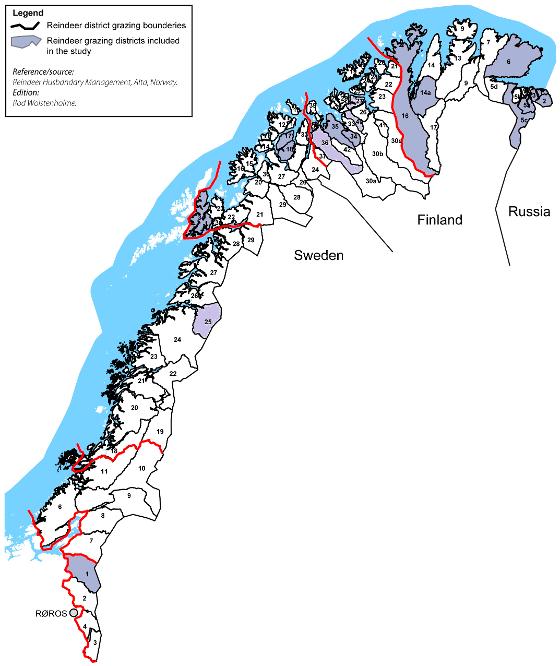Reindeer meat as food
This project was first launched in 2005 as a pilot. The pilot project was followed by a larger study in 2008-2012 with a greater number of samples of reindeer meat from a wider geographical area. The aim of the project was to enhance knowledge of reindeer meat as food and its importance for nutrition and health. The study was based on the fact that there has been little documentation of levels of nutrients and pollutants in reindeer meat and offal used as food.
Design and method
This was a cross-sectional study. The samples (meat, liver, tallow and bone marrow) were collected at reindeer slaughterhouses following standard procedures. They were then analysed for nutrient content (fat content, fatty acids, vitamins and minerals) and pollutants (persistent organic pollutants and heavy metals).
Sample and data collection
The project used samples from 131 reindeer from 14 grazing areas in four counties (Finnmark, Troms, Nordland and Sør-Trøndelag) in northern and central Norway. The samples were collected in two periods, 2004-2005 and 2008-2009. Most of the samples came from reindeer from Finnmark because Finnmark has the most reindeer grazing areas in Norway.

Research and findings
Data on nutrients, heavy metals and persistent organic pollutants have been published in international journals. In addition, a popular science article on nutrients and heavy metals in meat, liver, tallow and bone marrow from reindeer was published in the magazine Ottar and in the publication "Korsen e det med helsa di? Gokte don leak rupmaha bearri?" (“How’s your health?”)
The results show that consumption of reindeer meat and offal can make a significant contribution to the recommended amounts of several important nutrients. Furthermore, meat, liver, tallow and bone marrow from reindeer are safe to eat in terms of heavy metals and persistent organic pollutants, including from reindeer from grazing areas near the Russian border and with mining and military activity. Reindeer meat contains higher levels of vitamin B12, vitamin E, iron and zinc than meat from other Norwegian animals. Only minor geographical differences were seen in this study.
Publications
PhD dissertation
Hassan, Ammar Eltayeb Ali: Nutrients and toxic elements in semi-domesticated reindeer in Norway: Nutritional and food safety aspects. ISM skriftserie no. 129, 2012. (ISBN 13: 978-82-90263-44-2).
Articles
(Mar 2012) Hassan AA, Sandanger TM, Brustad M: Level of selected nutrients in meat, liver, tallow and bone marrow from semi-domesticated reindeer (Rangifer t. tarandus L.). Int J Circumpolar Health 2012, Vol. 71: 17997.
(Apr 2012) Hassan AA, Rylander C, Brustad M, Sandanger TM: Level of selected toxic elements in meat, liver, tallow and bone marrow of young semi-domesticated reindeer (Rangifer tarandus L.) from Northern Norway. Int J Circumpolar Health. 2012 Apr 4; 71(1): 18187, published online 4 Apr 2012.
(May 2012) Hassan AA, Brustad M, Sandanger TM: Concentrations and geographical variations of selected toxic elements in meat from semi-domesticated reindeer (Rangifer tarandus L.) in mid- and northern Norway: evaluation of risk assessment. Int J Environ Res Public Health. 2012 May; 9(5):1699-1714.
(May 2012) Hassan AA, Sandanger TM, Brustad M. Selected Vitamins and Essential Elements in Meat from Semi-Domesticated Reindeer (Rangifer tarandus tarandus L.) in Mid- and Northern Norway: Geographical Variations and Effect of Animal Population Density. Nutrients 2012, 4(7): 724-739. https://doi.org/10.3390/nu4070724.
(Dec 2013) Hassan AA, Rylander C, Brustad M, Sandanger TM. Persistent organic pollutants in meat, liver, tallow and bone marrow from semi-domesticated reindeer (Rangifer tarandus tarandus L.) in Northern Norway. Acta Veterinaria Scandinavica 2013, 55:57.
(2013) Hassan AA, Rylander C, Sandanger TM, Brustad M. Copper, Cobalt and Chromium in Meat, Liver, Tallow and Bone Marrow from Semi-domesticated Reindeer (Rangifer tarandus tarandus L.) in Northern Norway. Food and Public Health 2013, 3(3): 154-160.
(Juli 2021) Hassan AA, Haugdahl Nøst T, Brustad M, Sandanger TM. Concentrations and geographical patterns of persistent organic pollutants (POPs) in meat from semi-domesticated reindeer (Rangifer tarandus tarandus L.) in Norway. Science of The Total Environment, Volume 798, 2021, https://doi.org/10.1016/j.scitotenv.2021.149278.
Popular science articles
Brustad M, Hassan AA, Sandanger TM. Mattrygghet i nord. I «Samiske tall forteller 6. Kommentert samisk statistikk 2013”, kapittel 6. Kautokeino: Samisk høgskole 2013 (ISBN 978-82-7367-033-5) pp. 123-137.
Hassan AEA, Sandanger TM, Brustad M: Rein som næringsmiddel for mennesker. I “Broderstad AR, Silviken A (redaktører). Korsen e det med helsa di? Gokte don leak rupmaha bearri?”. Tromsø: Senter for samisk helseforskning, ISM, Det helsevitenskapelige fakultet, UiT Norges arktiske universitet 2015 (ISBN 978-82-996789-1-9) 59 s.
Hassan AA, Sandanger TM, Brustad M. Reinkjøtt - en næringsrik og trygg delikatesse fra nord. Ottar 2015, Volum 306, pp. 25-29. https://uit.no/Content/492962/ammar.pdf
Media articles
- Rein – en næringsbombe. Sagat 23.09.2020 (pluss-sak)
- Verdens sunneste kjøtt? I Arktisk julemat. Nordlys 08.11.2018
- Ferskt merke vil ta reinkjøttet fra fest til hverdag. Annonse. Harstad tidende 08.02.2018. HARSTAD TIDENDES MARKEDSAVDELING.
- Verdens sunneste kjøtt? – Nordlys 01.12.2016
- Dette er noe av det sunneste kjøttet du kan spise – KK 17.09.2016
- Supersunt kjøtt - Snåsanytt 02.02.2016
- Lite tungmetaller i reinkjøtt - NRK Sápmi 19.12.2015
- Reinsdyrkjøtt har like mye omega 3 som torsk og er like magert som kylling - Bergens Tidende 18.12.2015
- Reinsdyrkjøtt har like mye omega 3 som torsk og er like magert som kylling - Aftenposten 18.12.2015
- Reinkjøttets mottakelse i England - dailymail.co.uk 08.12.2015
- Reindeer meat is as healthy as fish - ScienceNordic 23.02.2013
- Kjøttet som er like sunt som fisk - KK 2013
- Reinsdyr like sunt som fisk - Pingvinen november 2012
- Supersunt reinsdyrkjøtt 08.11.2012
- Dette kjøttet er sunnest - ifinnmark.no 24.10.2012
- Dette kjøttet er sunnest - Avisa Nordland 24.10.2012
- Dette kjøttet er sunnest - Avisa Nordlys 24.10.2012
- Supersunt reinkjøtt - Helgelendingen 23.10.2012
- Sunt med reinsdyrkjøt - Framtida.no - 23.10.2012
- Supersunt reisndyrkjøtt - Regjeringen.no 22.10.12
- Reinsdyr like sunt som fisk - Forskning.no 20.10.2012
- Like sunt som fisk - iTromsø.no 19.10.12
- Reinkjøtt like sunt som fisk - NRK Sápmi 18.10.2012
- Reinkjøtt like sunt som fisk - World News 18.10.2012
- Supersunt reinsdyrkjøtt - Bladet kjøttbransjen 9, 2012
Contact
The project manager was researcher Ammar E. Ali Hassan.